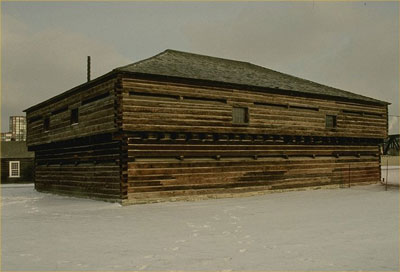Fort York National Historic Site of Canada
Toronto, Ontario

Exterior Photo
© Parks Canada/Parcs Canada 1991
Address :
250 Fort York Boulevard, Toronto, Ontario
Recognition Statute:
Historic Sites and Monuments Act (R.S.C., 1985, c. H-4)
Designation Date:
1923-05-25
Dates:
-
1813 to 1815
(Construction)
-
1932 to 1934
(Significant)
-
1949 to 1949
(Significant)
Event, Person, Organization:
-
John Graves Simcoe, Lt/Gov.
(Person)
Other Name(s):
-
Fort York
(Designation Name)
-
Blockhouse, East Magazine, Officer's Quarters and Mess, Soldier's Barracks, Blue Barracks
(Name of contributing resources)
Research Report Number:
1987-019, 2003-017, 2003-SDC/CDE-38
DFRP Number:
10002 00
Plaque(s)
Existing plaque: 100 Garrison Road, Toronto, Ontario
Fort York constituted the primary defensive position in early York (Toronto). The present buildings, erected between 1813 and 1815 to replace those destroyed during the American occupations of York in 1813, are among the oldest in Toronto and are important surviving examples of British military architecture. At the turn of the 20th century, the fort was threatened with demolition. The fight to save it led to one of the first victories of the Canadian heritage movement. The fort was bought by the city in 1909 and restored between 1932 and 1934 as part of Toronto's centennial celebration.
Description of Historic Place
Located in downtown Toronto, Ontario, near Lake Ontario, Fort York is a green open space in the midst of high-rise urban development, containing seven original War of 1812 buildings. The fort’s grounds and neighbouring environment encompass the birthplace of the city, remnants of the late eighteenth-century landscape, part of a 1813 battlefield, military cemeteries, and vast archaeological resources. Today the fort serves as a museum of the largest collection of War of 1812 buildings in Canada. The designation refers to a complex of eight buildings within an 3.24 ha. area enclosed by a restored, bastioned, stone-lined earthwork, the open mustering ground to the west, a military cemetery at Strachan Avenue, and other lands cut off from the main area by elevated roads.
Heritage Value
Fort York was designated a national historic sites of Canada in 1923 because: Fort York constituted the primary defensive position of early York (Toronto); and the seven buildings erected between 1813 and 1815 are important surviving examples of British military architecture.
The heritage value of this site resides in directly related resources, including War of 1812 seven buildings within the restored, bastioned earthwork, the open mustering ground to the west, a military cemetery at Strahan Avenue, and other related lands currently cut of the main area by elevated roads.
Fort York, the birthplace of the modern city of Toronto, was established in the late eighteenth century by the Lieutenant-Governor of Upper Canada John Graves Simcoe to house a garrison of British soldiers, creating a secure location which would attract permanent settlers. During the War of 1812, the fort was burned by invading Americans and subsequently rebuilt by the British who continued to garrison the fort. In 1870, they were replaced by Canadian forces who used the fort until the 1930s. Between 1932 and 1934, the City of Toronto restored the fort as a historic site. Further work was carried out in 1949.
Now separated from the fort by roads and a railway corridor, the military burial ground that forms part of Victoria Memorial Square was opened in 1794 for the internment of soldiers and their families. It was in use until 1863 by which time it had reached its capacity of 500 burials. Almost immediately the public moved to preserve it, both as a cemetery, and as public park. In 1905, it was renamed Victoria Memorial Square.
Source: Historic Sites and Monuments Board of Canada, Minutes,1923, 1926, 1930, 1931, 1958, 1987; Commemorative Integrity Statement, 2005.
Character-Defining Elements
Key elements contributing to the heritage value of this site include: the strategic location of the fort near the original shore of Lake Ontario; the cultural landscape comprising the bastioned fort, Garrison Common, and the cemetery, Victoria Memorial Square, with its natural setting including those portions of the ravine bank on the north and east sides which have not been modified and the western earth work, moat and those portions of other earthworks which align with the original trace and that contain significant amounts of original fabric; the complex of original buildings within a bastioned stone-lined earthwork including Blockhouses No.s 1 and 2, a brick powder magazine, a stone powder magazine, two brick soldiers’ barracks, and officers’ barracks and mess in their original spatial arrangement, massing, materials, design, craftsmanship, and finishes; associated archaeological sites including the subsurface remains of pre-War of 1812 buildings, remains of ten buildings from 1813-1815 and buildings from 1837and later, the remains of two batteries probably beneath Bathurst Street and the crater created by the explosion of the powder magazine and the glacis buried underneath fill outside the south rampart, and the original earthworks and the footprint of those removed during the 1930s restoration; the historic access route to the western entrance to the fort (Garrison Road) with viewscapes along the road from the fort, from the east (Bathurst Street) and north from the foot of the south ramparts; the open character of the mustering ground (Garrison Common) to the west of the fort; the military cemetery at Strachan Avenue in its original extent and safe remove from the fort proper, with its remaining headstones placed at the base of the monument in the middle of Victoria Memorial Square.